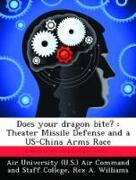Does Your Dragon Bite?: Theater Missile Defense and a Us-China Arms Race
BücherAngebote / Angebote:
China is one of the major actors in Asia with which the United States will have to deal in the next few decades. One especially charged topic of late has been the stated US intention to field some form of Theater Missile Defense (TMD). China has strongly opposed US deployment of such a system or systems to US Asia-Pacific allies such as Taiwan, Japan and South Korea. What is the likelihood of an arms race between China and the United States as a result of US deployment of TMD? What form might such a race take? What are the best courses of action for the United States over the next ten years? This paper addresses these questions by first briefly outlining the history of TMD development. Then it describes the considerations each country must take into account in addressing the issue of US TMD deployment into the region. This discussion includes the diplomatic or political arena, including policy statements, possible treaty implications, diplomatic relations between and among the regional actors, and relevant domestic political concerns. Next the paper addresses each country`s regional security goals, Chinese modernization efforts, and possible countermeasures to TMD, the discussion concludes with likely regional conflict scenarios in which the United States and China might become involved, and a few relevant economic considerations. After briefly analyzing the likelihood and probable nature of an arms race in light of these factors, the paper presents recommended US courses of action regarding development and deployment of TMD in the region. These courses include continuing to aggressively develop TMD, deploying TMD initially for force protection only, negotiating a TMD treaty with China, negotiating a moratorium on actions related to Taiwan, publishing a protocol outlining the specific purposes of TMD, and pursuing confidence and security building measures with China regionally as well as bilaterally.
Folgt in ca. 15 Arbeitstagen

